Situation on the financial markets
Market






2017 was a stellar year for investing on the global financial markets. The upward movement of global stock indices continued despite the fact that the ninth year of the bull market already begun in the United States. Sovereign bond yields on the core markets increased only slightly. The good economic conditions on financial markets were supported by a synchronized global economic recovery and reduction in uncertainty. A series of elections in key European Union countries brought outcomes suppressing the risk of disintegration of the EU and the euro area, and the last months of the year were also marked by a declining risk of a ‘hard Brexit’. Nor did the concerns about a significant increase in protectionist policies in the global economy materialize. The positive trends on the financial markets were not disturbed either by the temporary manifestation of other risks in 2017, such as the declaration of independence by Catalonia or an increase in geopolitical risk related to North Korea’s nuclear programme. Despite the clear economic recovery, the announced reduction in the ECB net asset purchase programme and the commencement of contraction of the FED balance sheet, the effects of the “quantitative easing” policy still prevailed globally, which, in presence of relatively low inflation, helped to restrain the increases in bond yields on global markets.
In 2017, the Polish stock market was one of the fastest- growing equity markets in the world. In 2017 the WIG index rose 23.2%, while the WIG20 index shot up 26.4%. Faced with the acceleration of global economic growth, declining political risk in Europe and the improvement of economic conditions in Poland, at the beginning of the year we observed increases in all major stock market indices in Poland. Starting roughly at the beginning of the second quarter, certain differences appeared in the paths followed by large and small cap indices. While the large cap index WIG20 gained 13.11% from the beginning of April to year-end (driven mainly by increased valuation of companies in the energy and banking sectors), the sWIG80 small cap index lost 10.90% in that period (even though it rebounded in mid-November).
WIG20 and sWIG80 index in 2017

Polish PLN government bonds, except for one-year bonds, also increased in value in 2017. From January to June, in connection with the decreasing uncertainty on global financial market, the unexpectedly high economic growth rate and the improving situation of the state budget in Poland, we could observe a decline in the yield of 10-year government bonds from about 3.90% to roughly 3.15%. From the end of June, the yield of 10-year PLN government bonds varied from 3.15% to 3.51%. In the first half of 2017, the spread between Polish and German 10-year sovereign bonds narrowed down. After a slight rebound in July, the spread stabilized later in the year. Additionally, the Polish yield curve flattered in 2017. The yield of Polish government debt securities with 1-year maturity remained virtually unchanged, reaching slightly more than 1.45% at the end of 2017. The yield on 2-year government bonds decreased over the year by 32 basis points to 1.71%, while the yields on 5-year and 10-year bonds fell by 24 and 33 basis points to 2.65% and 3.30%, respectively.
Treasury bond yields

In 2017, the main currency markets showed a clear trend of the euro appreciating against the US dollar and the Swiss franc. Ultimately, the EUR/USD exchange rate rose by 13.8% in 2017, while the EUR/CHF rose by 9.2%. In that period the Polish zloty appreciated against the major global currencies. Over 2017, the USD/PLN exchange rate fell by as much as 16.7% to about 3.48, while the euro was worth about PLN 4.17 at the end of 2017 (down by 5.7% compared to the end of 2016). Additionally, the Polish zloty appreciated against the Swiss franc by 13.4% (the CHF/PLN exchange rate fell to roughly 3.57).
PLN exchange rates


